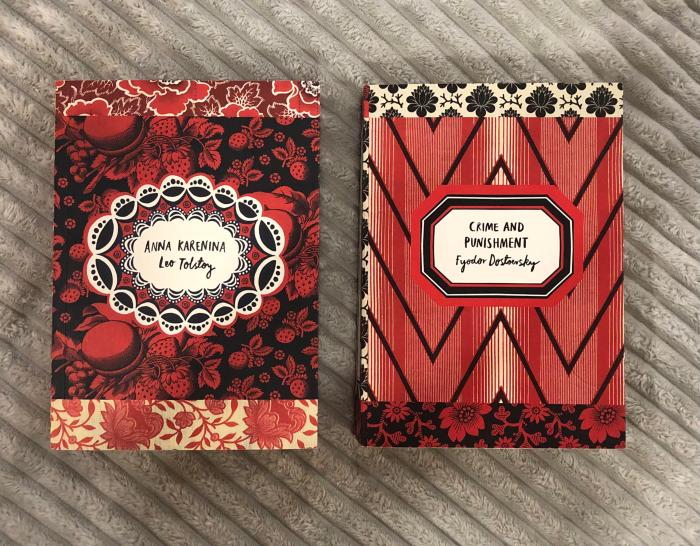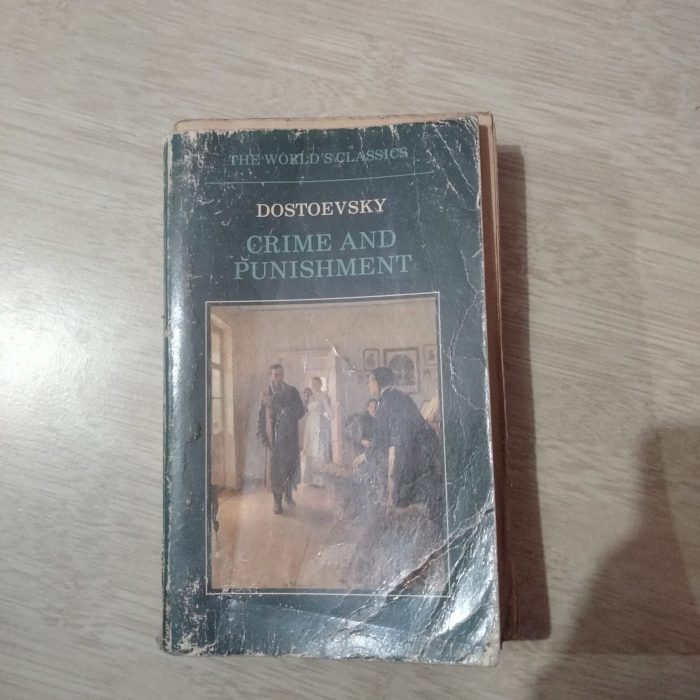Ready to dive into a mind-bending tale of guilt, redemption, and the dark side of human nature? “Crime and Punishment (Vintage Classics)” by Fyodor Dostoevsky is not your typical whodunit. It’s a psychological thriller that throws you right into the head of Rodion Raskolnikov, a troubled ex-student who commits a brutal crime and is haunted by its consequences.
This book is like a Russian rollercoaster ride of emotions, keeping you on the edge of your seat as you witness Raskolnikov’s descent into madness and his struggle to find his way back to sanity.
Get ready to meet a cast of unforgettable characters, including Sonia Marmeladova, a young woman forced into prostitution to support her family, and Porfiry Petrovich, the brilliant detective who unravels Raskolnikov’s twisted logic. This isn’t just a story about a crime; it’s a deep exploration of themes like poverty, social injustice, and the very nature of good and evil.
You’ll be left pondering the moral complexities of the story long after you’ve finished the last page.
Plot Summary and Key Characters

Crime and Punishment, a masterpiece of Russian literature by Fyodor Dostoevsky, is a gripping tale of guilt, redemption, and the complexities of the human psyche. The story follows Rodion Raskolnikov, a former student living in poverty in St. Petersburg, as he grapples with his philosophical ideas and ultimately commits a heinous crime.Raskolnikov, a brilliant but impoverished former student, develops a radical theory that justifies murder in certain circumstances.
He believes that extraordinary individuals are above the law and can transgress moral boundaries for the greater good. Driven by desperation and his twisted ideology, he murders an elderly pawnbroker, Alyona Ivanovna, and her sister, Lizaveta, in a brutal act of violence.
Key Characters
The novel features a cast of compelling characters who play pivotal roles in Raskolnikov’s journey:
- Rodion Raskolnikov: The protagonist, a former student driven by poverty and a twisted philosophy to commit murder. He struggles with guilt, paranoia, and the psychological consequences of his crime.
- Sonia Marmeladova: A young woman forced into prostitution to support her family. She becomes a symbol of compassion and faith, offering Raskolnikov spiritual guidance and ultimately leading him to confess his crime.
- Porfiry Petrovich: A shrewd and enigmatic investigator who suspects Raskolnikov from the beginning. He employs psychological tactics to unravel the truth, pushing Raskolnikov to confess his guilt.
- Dunya: Raskolnikov’s sister, a kind and devoted woman who works as a governess to support her family. She is deeply concerned about her brother’s well-being and tries to help him escape the consequences of his crime.
The Significance of the Crime
Raskolnikov’s murder is not simply a violent act but a pivotal moment in the narrative. It exposes the dark underbelly of St. Petersburg, highlighting the social injustices and poverty that drive individuals to desperation. The crime also serves as a catalyst for Raskolnikov’s internal struggle, as he is haunted by guilt, paranoia, and the weight of his actions.
His psychological torment becomes a central theme of the novel, as he grapples with the consequences of his choice and the conflicting forces within his own soul.
Themes and Motifs
Crime and Punishment is a literary masterpiece that delves into the complexities of human nature, exploring themes of guilt, redemption, poverty, social justice, and the nature of good and evil. Dostoevsky masterfully weaves these themes throughout the narrative, using recurring motifs like the color red, dreams, and the symbolism of St.
Petersburg to enhance the story’s impact and deepen its meaning.
Guilt and Redemption
The novel centers on the psychological torment of Rodion Raskolnikov, a former student driven to poverty who commits murder to prove his theory that he is above the law. Raskolnikov’s crime weighs heavily on his conscience, and he is consumed by guilt and paranoia.
The theme of guilt is further explored through the characters of Sonya Marmeladova, a young woman forced into prostitution to support her family, and Svidrigailov, a morally ambiguous figure who represents the consequences of unchecked self-interest. Through these characters, Dostoevsky examines the different ways in which guilt manifests itself and the potential for redemption.
Literary Style and Techniques

Dostoevsky’sCrime and Punishment* is a masterpiece of psychological realism, a literary movement that emphasizes the inner lives and motivations of characters. He utilizes a variety of techniques to achieve this, including internal monologue, symbolism, and a unique structure and pacing.
Psychological Realism
Dostoevsky’s primary focus is on the psychological states of his characters, particularly Raskolnikov. He delves into Raskolnikov’s thoughts, feelings, and motivations, exploring the complex interplay of guilt, remorse, and self-justification.
“I was a madman then, I must have been, but I wasn’t a murderer. I was a madman, but I was not a murderer, not then!”
This quote from Raskolnikov’s internal monologue reveals his inner turmoil and struggle to reconcile his actions with his conscience. Dostoevsky masterfully captures the nuances of Raskolnikov’s psychological state, providing a deep and unsettling insight into the human mind.
Internal Monologue
Internal monologue is a key technique used by Dostoevsky to showcase the characters’ inner thoughts and feelings. Raskolnikov’s internal monologues are often fragmented and stream-of-consciousness, reflecting the chaotic nature of his mental state.
“Is it possible that I really did that? Is it possible that I am capable of such a thing?”
You know, reading Dostoevsky’s “Crime and Punishment” can be a real mind-bender. It’s like, you’re stuck in Raskolnikov’s head, and the guilt just keeps piling up. But hey, maybe a little DIY project could help clear your mind. Check out these Valet Woodworking Plans: Build Your Own Stylish Storage – a little woodworking therapy might be just what you need to escape the psychological drama of “Crime and Punishment.” You could even build a special shelf to house your vintage copy of the book!
These internal monologues allow the reader to witness the characters’ thought processes, providing a unique perspective on their motivations and actions.
Symbolism
Symbolism plays a significant role inCrime and Punishment*, enhancing the novel’s thematic depth. One prominent symbol is the color yellow, which is often associated with Raskolnikov’s guilt and paranoia.
“He was a man who had been sick for a long time. He was pale, his face was drawn and his eyes were sunken. He was wearing a yellow shirt and his hair was unkempt.”
You know how Raskolnikov in “Crime and Punishment” is all about guilt and redemption? Well, maybe he should check out Vintage Woodworking Plans: A Guide to Traditional Craftsmanship to learn a new skill and find some peace. Building something with your own hands, like a beautiful wooden table, could be just the therapy he needs to get his head straight.
Plus, it’s way less messy than axing a pawnbroker, right?
The recurring motif of yellow underscores Raskolnikov’s psychological state, emphasizing his isolation and the weight of his crime.
Yo, if you’re into classic lit, you gotta check out Crime and Punishment. It’s like, the OG psychological thriller, right? This book will make you think about the dark side of humanity, and you’ll be hooked from the first page.
And if you want to listen to it on the go, you can totally Download And Listen Here. You’ll be able to get your fix of Dostoevsky wherever you are, whether you’re chilling at home or on the bus.
Just sayin’, this book is a must-read for anyone who wants to dive into the deep end of literature.
Structure and Pacing
The novel’s structure and pacing are crucial to its impact. The narrative is divided into eight parts, each focusing on a specific aspect of Raskolnikov’s psychological journey.
You know how Raskolnikov in Crime and Punishment thinks he’s above the law? Well, maybe he just needs a little DIY therapy. If he was really feeling guilty, he could build himself a sweet treasure chest using these Toybox Woodworking Plans: Build a Treasure Chest and stash all his ill-gotten gains inside.
Then, he could finally face his demons, or at least his guilt, head-on.
“The first part of the novel focuses on Raskolnikov’s crime and its immediate aftermath. The second part delves into his guilt and paranoia. The third part introduces Sonia, a character who plays a pivotal role in Raskolnikov’s redemption.”
Dostoevsky carefully paces the narrative, building suspense and tension as Raskolnikov’s psychological state deteriorates. This deliberate pacing allows the reader to fully experience Raskolnikov’s descent into madness and eventual struggle for redemption.
Final Review

“Crime and Punishment (Vintage Classics)” is a timeless masterpiece that continues to resonate with readers today. Dostoevsky’s masterful storytelling weaves together a complex web of characters, themes, and psychological insights, leaving you with a profound understanding of the human condition.
So, buckle up, grab a cup of strong coffee, and prepare to be captivated by one of the most powerful and thought-provoking novels ever written.
FAQ Overview
What is the significance of the color red in the novel?
Red is a recurring motif that symbolizes blood, guilt, and passion. It often appears in connection with Raskolnikov’s crime and his internal struggles.
Is there a movie adaptation of “Crime and Punishment”?
Yes, there have been several film adaptations of “Crime and Punishment,” including the 1970 version starring George C. Scott and the 2002 version starring Paul Bettany.
What is the main difference between Raskolnikov and Porfiry Petrovich?
Raskolnikov is driven by his own twisted philosophy and a sense of superiority, while Porfiry Petrovich represents the law and justice. They represent contrasting ideologies and approaches to morality.

